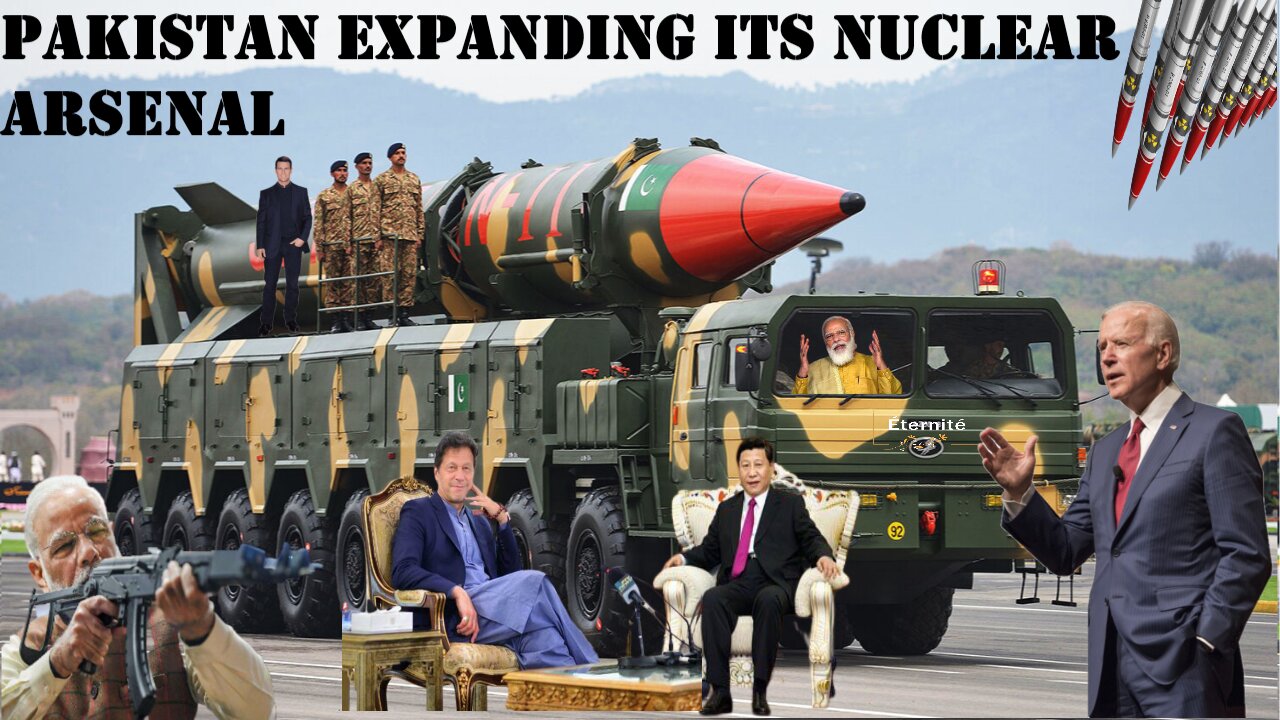Premium Only Content

Pakistan Expanding Its Nuclear Arsenal
Pakistan Expanding Its Nuclear Arsenal
Pakistan Expanding Its Nuclear Arsenal
Pakistan continues to expand its nuclear arsenal with more warheads, more delivery systems, and a growing fissile material production industry.
1999, a publication by the US Defense Intelligence Agency (DIA) titled 'A Primer on the Future Threat: the Decades Ahead 1999-2020' predicted that Pakistan’s estimated nuclear warheads would reach somewhere from 60 to 80. Fast forward to September 2021, a nuclear notebook published in the journal Bulletin of the Atomic Scientists estimates that Pakistan has expanded its nuclear stockpile to approximately 165 warheads.
According to the Chicago-based independent nonprofit publication, “Pakistan continues to expand its nuclear arsenal with more warheads, more delivery systems, and a growing fissile material production industry.” Prepared by Hans M. Kristensen, director of the Nuclear Information Project (NIP) at the Federation of American Scientists, and Matt Korda, research associate for the NIP, the publication argues that Pakistan is likely to continue expanding its nuclear capabilities over the next few years. “We estimate that the country’s stockpile could more realistically grow to around 200 warheads by 2025 if the current trend continues.” The government of Pakistan has never publicly disclosed the size of its nuclear arsenal.
PAKISTAN'S NUCLEAR CAPABILITIES
Pakistan has been trying to develop new short-range tactical weapons, sea-based cruise missiles, air-launched cruise missiles, and longer-range ballistic missiles for some time now. Pakistan has at least six operational nuclear-capable land-based ballistic missiles, including the short-range (60-70 km) NASR (Hatf-9) solid-fuel missile.
“With a range too short to attack strategic targets inside India, NASR appears intended solely for battlefield use against invading Indian troops,” Kristensen and Korda write in their paper.
Pakistan is also developing a multiple independent reentry vehicle (MIRV) technology-enabled nuclear-capable ballistic missile Ababeel. Pakistan is also reportedly upgrading its original Babur1 missiles into Babur-1A, and Babur-2/Babur-1B versions to improve their capabilities. An under-development sea version named Babur-3 is likely to be used with the diesel-electric Agosta class submarines, once ready. “It is possible that these new submarines, which will be called the Hangor-class, could eventually be assigned a nuclear role with the Babur-3 submarine-launched cruise missile,” the paper points out.
In terms of Pakistan’s aircraft capabilities, the nuclear notebook doesn’t feature the nuclear capabilities of Pakistan’s F-16s and JF-17s aircraft citing the “uncertainties”. Pakistan has two versions of US-made F-16s as well as the China-assisted JF-17 fighter jets; however, the nature of their nuclear capabilities remains unclear. Pakistan was obligated by contract with the US to not modify its earlier versions of older F-16(A/B), but various reports suggested that Pakistan might have modified those aircraft long back.
Pakistan Air Force’s (PAF) Mirage III and Mirage V fighter squadrons are likely to have nuclear delivery capabilities as well. Masroor Air Base near Karachi housing three Mirage squadrons has a “possible nuclear weapons storage site” nearby that, according to the authors, has been witnessing continuous underground constructions and expansions. “This includes a possible alert hangar with underground weapons-handling capability,” the publication points out.
Another PAF base near Shorkot in Punjab houses two Mirage squadrons as well. Pakistani policymakers have expressed their views on replacing the aging Mirage aircraft with the JF-17s.
According to the report, the National Defence Complex in the Kala Chitta Dahr mountain range is ground zero to produce nuclear-capable missiles and launchers.
According to the International Panel on Fissile Materials, Pakistan had approximately 3,900 kg of weapon-grade highly enriched uranium and about 410 kg of weapon-grade plutonium in early 2020. But the authors of the nuclear notebook argue that calculating stockpile size solely based on fissile material inventory could be a wrong approach.
international campaign to abolish nuclear weapons,nuclear weapons,pakistan, english,india and pakistan,nuclear war,norway,nobel peace prize,peace prize,nuclear,nuclear arms,India and Pakistan: Rivals in a nuclear arms race
-
 13:55
13:55
Clownfish TV
13 hours agoOrcs REMOVED from Dungeons & Dragons New Monster Manual?!
4914 -
 15:38
15:38
Chris From The 740
4 hours agoThe EAA Girsan Match X 2311 : Premium Features, Unbeatable Value!
581 -
 14:23
14:23
Degenerate Jay
2 hours agoPeople Forgot What Metal Gear Solid Is?
562 -
 1:01:23
1:01:23
FamilyFriendlyGaming
15 hours ago $2.49 earnedCat Quest III Episode 14
15.6K -
 3:16:59
3:16:59
RG_GerkClan
4 hours ago🔴LIVE - Dominating One Raid at a Time - Escape From Tarkov - Gerk Clan
15.1K -
 1:49:43
1:49:43
Game On!
13 hours ago $1.64 earnedNFL Experts Top 10 Super Bowl Props!
13.8K2 -
 28:31
28:31
SB Mowing
1 day agoSiblings FEUD went so far the grass grew TALLER THAN THE HOUSE
56.8K11 -
 26:32
26:32
Stephen Gardner
15 hours ago🔥Tulsi Gabbard DROPS BOMBSHELL Obama Secret during hearing!
64.2K113 -
 4:42
4:42
SeasonofMist
5 months agoSYLVAINE - Dagsens Auga Sloknar Ut (Official Music Video)
34 -
 31:54
31:54
Jamie Kennedy
9 hours agoThe "Tolerant Left" is Getting Exposed
146